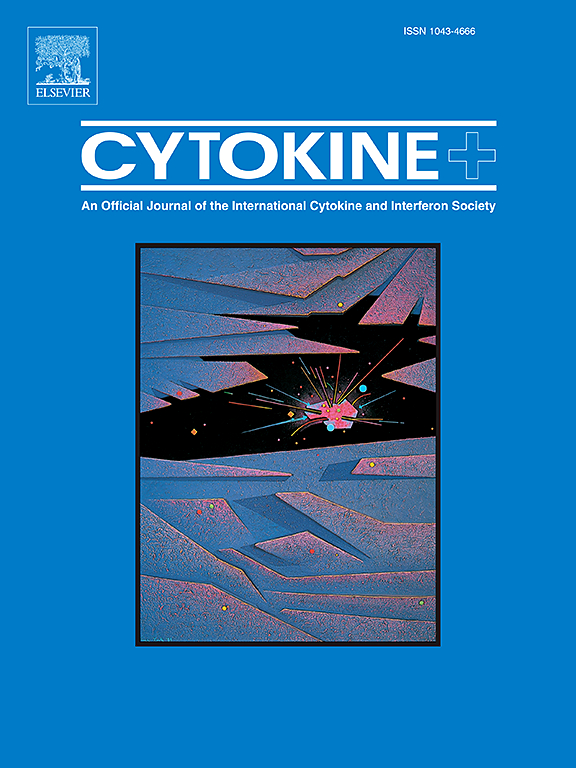甲状腺相关性眼病患者外周血单核细胞CD4 + T细胞外泌体表达前颗粒蛋白及其相关机制
IF 3.7
3区 医学
Q2 BIOCHEMISTRY & MOLECULAR BIOLOGY
引用次数: 0
摘要
背景:外周血单核细胞(PBMCs) CD4 + T细胞外泌体在甲状腺相关性眼病(TAO)中的表达及相关免疫机制是目前研究的热点。材料与方法:将27例活动性TAO患者与59例健康人纳入研究进行比较。从患者血液中分离PBMCs,用人naïve CD4微珠纯化naïve CD4+ T细胞。一个共培养组不添加PGRN,作为PGRN未处理组(AG),另一个共培养组添加提取的PGRN,作为PGRN处理组(BG)。取健康人血液中的CD4+ T细胞作为对照组(CG)。结果:TAO患者血清PGRN浓度明显高于CG;BG中白细胞介素(IL-10)、IL-4、IL-17含量明显低于AG;与AG相比,BG细胞因子蛋白和mRNA表达明显降低;BG组CD4 + T细胞增殖水平明显低于AG组,凋亡水平明显高于AG组(P <;0.05)。结论:PGRN可能参与了TAO的发病机制。它可以通过减少CD4+ T细胞源性外泌体中细胞因子的释放,抑制CD4+ T细胞的增殖,促进其凋亡来调节免疫应答。本文章由计算机程序翻译,如有差异,请以英文原文为准。

Expression of Progranulin and its related mechanism with exosomes from peripheral blood mononuclear cells CD4 + T cells in patients with thyroid-associated ophthalmopathy
Background: The expression of serum progranulin (PGRN) and the related immunological mechanisms of peripheral blood mononuclear cells (PBMCs) CD4 + T cells exosomes in thyroid-associated ophthalmopathy (TAO) are currently hot topics of research. Material and Method: A total of 27 patients with active TAO and 59 healthy individuals were included in the study for comparison. PBMCs were isolated from the patients' blood, and naïve CD4+ T cells were purified using human naïve CD4 microbeads. One co-culture group was not supplemented with PGRN, serving as the PGRN-untreated group (AG), while another group was supplemented with extracted PGRN, serving as the PGRN-treated group (BG). CD4+ T cells derived from the blood of healthy individuals were used as the control group (CG). Result: The serum PGRN concentration in TAO patients was visibly higher as against the CG; The contents of interleukin (IL-10), IL-4, and IL-17 in BG were visibly lower as against AG; The protein and mRNA expression of cytokines in BG were visibly lower as against AG; The proliferation level of CD4 + T cells was visibly lower, and the apoptosis level was visibly higher in BG as against AG (P < 0.05). Conclusion: PGRN may be implicated in the pathogenesis of TAO. It could modulate the immune response by reducing cytokine release in CD4+ T cell-derived exosomes, inhibiting the proliferation of CD4+ T cells, and promoting their apoptosis.
求助全文
通过发布文献求助,成功后即可免费获取论文全文。
去求助
来源期刊

Cytokine
医学-免疫学
CiteScore
7.60
自引率
2.60%
发文量
262
审稿时长
48 days
期刊介绍:
The journal Cytokine has an open access mirror journal Cytokine: X, sharing the same aims and scope, editorial team, submission system and rigorous peer review.
* Devoted exclusively to the study of the molecular biology, genetics, biochemistry, immunology, genome-wide association studies, pathobiology, diagnostic and clinical applications of all known interleukins, hematopoietic factors, growth factors, cytotoxins, interferons, new cytokines, and chemokines, Cytokine provides comprehensive coverage of cytokines and their mechanisms of actions, 12 times a year by publishing original high quality refereed scientific papers from prominent investigators in both the academic and industrial sectors.
We will publish 3 major types of manuscripts:
1) Original manuscripts describing research results.
2) Basic and clinical reviews describing cytokine actions and regulation.
3) Short commentaries/perspectives on recently published aspects of cytokines, pathogenesis and clinical results.
 求助内容:
求助内容: 应助结果提醒方式:
应助结果提醒方式:


